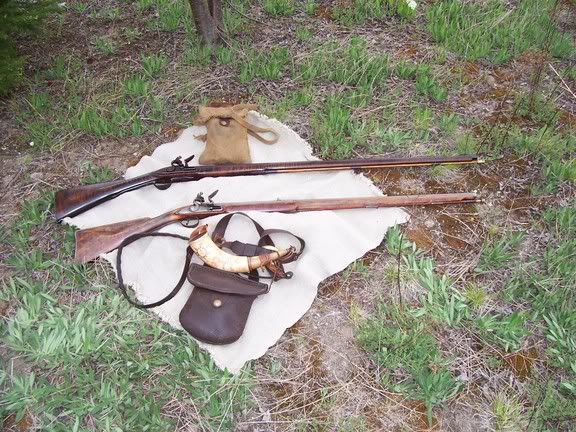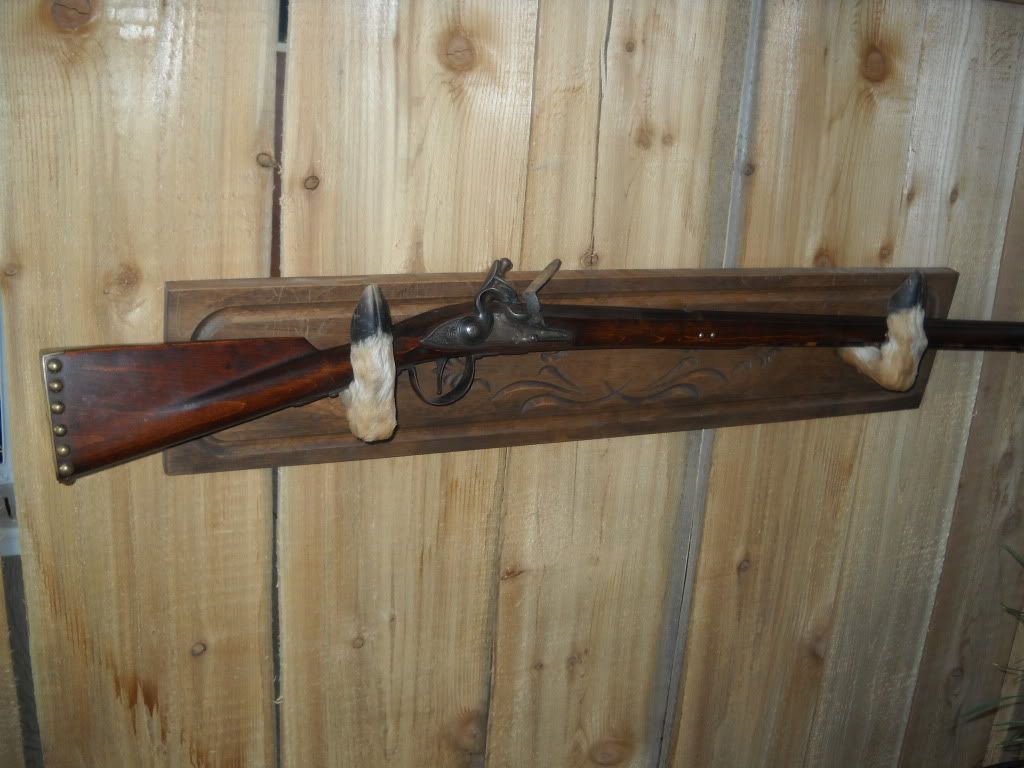|
|
Post by Cap't Bridger on Jul 7, 2010 5:28:30 GMT -7
We all have an image of every trapper carrying a rifle,,and I feel that by far and large they ,,,,,,,,,did. What I'd be interested in knowing,,,getting a feel for,,,,is how smooth-bore guns were utilized in the fur trade era west of the Mississippi.
|
|
|
|
Post by Chuck Burrows on Jul 7, 2010 5:48:50 GMT -7
Mike it all depends on who the trappers were and where from... All of the extant journals, most of which were written by "Anglos" (my shorthand for trappers of European origin other than the French) state that the Anglos carried rifles while most of the HBC folks and others including the French, Metis, and western Indians made wide use of the smoothbores - most notably NW trade guns. Warren Ferris notes this in his journal (see it here www.xmission.com/~drudy/amm.html) and states that fusils were only used by Anglos while running buffalo. Other mainly rifle users during the RMFT period were many of the displaced eastern Indians such as the Delaware (one tough group by all accounts), Shawnee, Choctaw, etc.As always though there were undoubtedly exceptions, but overall the above is what is noted in the period journals and is in fact in keeping with what Mick Archer calls the "cult of the rifleman" during that period. One advantage noted in the journals is the extra range and accuracy at longer distance of the rifle, especially since the Indians seemed to have often used light loads in their fusils. One form of smoothbore mentioned as used in the latter days by the Anglos was the double shotgun, often used for night guard duty. |
|
|
|
Post by Steve Jajo on Jul 7, 2010 17:14:26 GMT -7
Here is a pic of a couple of my smoothbores. Both are .62 caliber. I built the gun on the top and did a little work on the other one since this photo was taken.  |
|
|
|
Post by dennis on Jul 7, 2010 19:09:26 GMT -7
|
|
|
|
Post by pathfinder on Jul 7, 2010 20:26:54 GMT -7
After the Corps of Discovery expedition and difficulty they had killing the big bears, I would suggest that perhaps bigger caliber rifles with shorter barrels became the standard and that's what was most common. Overall bigger big game and greater distances required larger bored rifles.......think Jeremiah Johnson and Hatchet Jack! ;D
|
|
|
|
Post by pathfinder on Jul 7, 2010 20:28:03 GMT -7
Nice Dennis!
|
|
|
|
Post by pathfinder on Jul 8, 2010 10:17:34 GMT -7
Just to keep things rolling a bit......here's my trade gun. Common gun, native decorated. I tried to make it an early model for RMFT but I can't remember now which builder I tried to model. 20 ga. fun to shoot! I have a story but I'll wait for later.  |
|
|
|
Post by Chuck Burrows on Jul 8, 2010 22:49:42 GMT -7
After the Corps of Discovery expedition and difficulty they had killing the big bears, I would suggest that perhaps bigger caliber rifles with shorter barrels became the standard and that's what was most common. Overall bigger big game and greater distances required larger bored rifles.......think Jeremiah Johnson and Hatchet Jack! ;D Doug - a good thought but the trad records for guns going west says otherwise. In general rifles were made in calbers from 45-54 and with barrels lengths averaging around 42" - the shortest order I've seen pre-1840 were for 38" barrels, but many others ordered were up to even 48". Ashley is supposed to have ordered a big bore (.62 IIRC but maybe .69??) from Sam Hawken and the John Brown J & S in Salt Lake City is a .66. The Modena/Medina rifle is .58, but it's a later rebarrel and was most likely birthed at .50-.54. Smoothbores also stayed mostly in the lighter gauges with 24-28 gauge being the most common based on the orders I've seen. There are some 16's and 20's in the mix too and the later double barrels were in often in 10-12. Killing griz was a problem well into the big bore cartridge era - heck it still is. The one time I came face to face (about 10-15 feet away) with one of those bad boys was up near Campbell River, BC - I had a 375 H & H in hand and wished it was a 20mm cannon. The pucker factor was at plus 100 for a few moments - then he caught my scent and disappeared into a devils club jungle. I was one big happy camper at that point! Anyway thansk for posting the pics - some good stuff there. I need to take pics of my two smoothies (a 26 ga fowler and a 20 ga smooth rifle) and post them I reckon... |
|
|
|
Post by sean on Jul 9, 2010 7:39:19 GMT -7
The most common smoothbore in the western fur trade was the NW gun, not so much because it was a jack of all trades gun, but because 1) it was inexpensive and reliable and 2) in the West it was a specialized tool largely for running bison. That is not to say there were no fowlers and smoothrifles in the West. The oft cited fine fusil of Charboneau is one example, but there's another. McCloskey and Olsen's book 'Supply and Demand' includes some writings by Allen Chronister where he notes the purchase of a 'smooth board rifle' from the Hawken shop by an UMO employee in 1839. This by no means says that Hawken smoothrifles were a common thing in the West. But it does speak to the breadth of variability in guns and the desire of individuals for specific things that were outside the norm for trade goods.
Sean
|
|
|
|
Post by pathfinder on Jul 9, 2010 7:56:14 GMT -7
Chuck I stand corrected.......I've forgotten more than I remember. I remember reading many years ago the average caliber for rifles was .53 caliber, but I might have that wrong as well. When I said shorter I was mostly referring to anything shorter than the average musket length of 42". Remember the whole debate on "short rifles" of Corps of Discovery. The one Hawken I ever handled was in the 38" range but I have no idea how late it was. This may result in me rethinking the correctness of my old 28" barreled Leman.................part of my original reasoning for getting it was so I could throw it into a saddle scabbard.  |
|
|
|
Post by sean on Jul 9, 2010 10:46:51 GMT -7
PF,
I would guess an average barrel length for Hawkens would be maybe 38-39". The gun that is thought to be Parkman's had a 43" barrel. IIRC Tobin's hawking was 39-40". I've always kind of figured that the trend toward larger, heavier barrels was more a response to shooting out on windy Plains. I think the trend towards target rifles in the east in the 1850's increased there prevalance. Just about all of the 1/2 stocked Plains rifles I've had in hand were a heck of a lot heavier and less handy than earlier flint full stocks. Appalachian rifles are the exception there. Most of those are slim, but really heavy unwieldy cusses designed for turkey and beef shoots.
As for trends in caliber, I've never really been sold on that. The early trade records these are often based on from the first 2 decades or so of the 1800s are heavily slanted towards treaty arms. Natives showed a marked preference for smaller caliber rifles, but I've seen more than half a dozen early Deringer rifles that are likely pre-1825 with bores that appear to be originally in the .58-.60 range. I've also seen a lot of .44-.46 cal halfstocked Plains-type rifles with Plains use provenances.
Sean
|
|
|
|
Post by Librarian on Jul 9, 2010 17:52:02 GMT -7
How do! " Overall bigger big game and greater distances required larger bored rifles.......think Jeremiah Johnson and Hatchet Jack! " The real "Jeremiah Johnson's" Gemmer Spencer/Hawken?   |
|
|
|
Post by pathfinder on Jul 9, 2010 21:22:09 GMT -7
"The Crow Killer" read 32 years ago!  |
|
jeffp
Mountaineer

Posts: 48
|
Post by jeffp on Jul 12, 2010 11:16:53 GMT -7
Nice smoothie Dennis....too nice fer yer meaty ol' paws! ;D
|
|
|
|
Post by dennis on Jul 13, 2010 12:11:47 GMT -7
Nice smoothie Dennis....too nice fer yer meaty ol' paws! ;D It's purty, like me. and thanks. she is a punkin. |
|